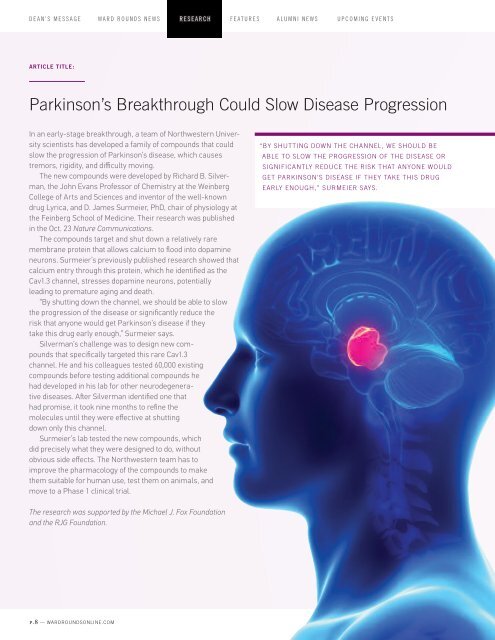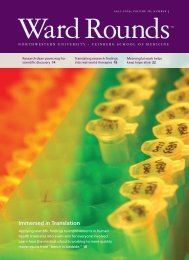Download PDF - Ward Rounds - Northwestern University
Download PDF - Ward Rounds - Northwestern University
Download PDF - Ward Rounds - Northwestern University
You also want an ePaper? Increase the reach of your titles
YUMPU automatically turns print PDFs into web optimized ePapers that Google loves.
DEAN’S MESSAGE WARD ROUNDS NEWS RESEARCH FEATURES ALUMNI NEWS UPCOMING EVENTS<br />
Article Title:<br />
Parkinson’s Breakthrough Could Slow Disease Progression<br />
In an early-stage breakthrough, a team of <strong>Northwestern</strong> <strong>University</strong><br />
scientists has developed a family of compounds that could<br />
slow the progression of Parkinson’s disease, which causes<br />
tremors, rigidity, and difficulty moving.<br />
The new compounds were developed by Richard B. Silverman,<br />
the John Evans Professor of Chemistry at the Weinberg<br />
College of Arts and Sciences and inventor of the well-known<br />
drug Lyrica, and D. James Surmeier, PhD, chair of physiology at<br />
the Feinberg School of Medicine. Their research was published<br />
in the Oct. 23 Nature Communications.<br />
The compounds target and shut down a relatively rare<br />
membrane protein that allows calcium to flood into dopamine<br />
neurons. Surmeier’s previously published research showed that<br />
calcium entry through this protein, which he identified as the<br />
Cav1.3 channel, stresses dopamine neurons, potentially<br />
leading to premature aging and death.<br />
“By shutting down the channel, we should be able to slow<br />
the progression of the disease or significantly reduce the<br />
risk that anyone would get Parkinson’s disease if they<br />
take this drug early enough,” Surmeier says.<br />
Silverman’s challenge was to design new compounds<br />
that specifically targeted this rare Cav1.3<br />
channel. He and his colleagues tested 60,000 existing<br />
compounds before testing additional compounds he<br />
had developed in his lab for other neurodegenerative<br />
diseases. After Silverman identified one that<br />
had promise, it took nine months to refine the<br />
molecules until they were effective at shutting<br />
down only this channel.<br />
Surmeier’s lab tested the new compounds, which<br />
did precisely what they were designed to do, without<br />
obvious side effects. The <strong>Northwestern</strong> team has to<br />
improve the pharmacology of the compounds to make<br />
them suitable for human use, test them on animals, and<br />
move to a Phase 1 clinical trial.<br />
“By shutting down the channel, we should be<br />
able to slow the progression of the disease or<br />
significantly reduce the risk that anyone would<br />
get Parkinson’s disease if they take this drug<br />
early enough,” Surmeier says.<br />
The research was supported by the Michael J. Fox Foundation<br />
and the RJG Foundation.<br />
p.8 — wardroundsonline.com












